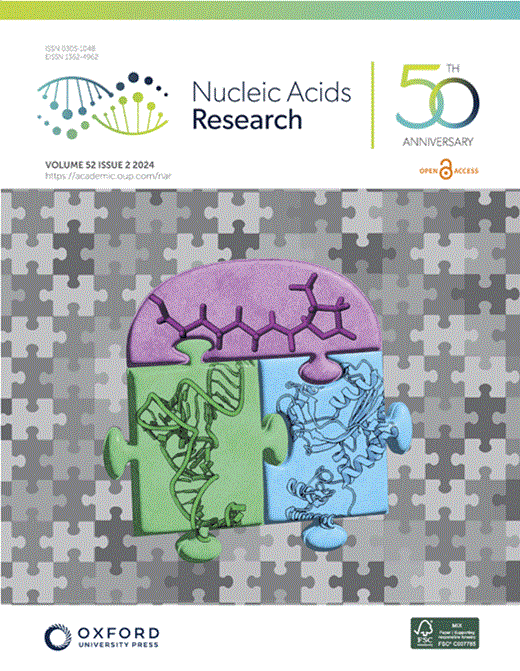Cryo-EM structures of DNA-free and DNA-bound BsaXI: architecture of a Type IIB restriction–modification enzyme
IF 16.6
2区 生物学
Q1 BIOCHEMISTRY & MOLECULAR BIOLOGY
引用次数: 0
Abstract
We have determined multiple cryogenic electron microscopy (cryo-EM) structures of the Type IIB restriction–modification enzyme BsaXI. Such enzymes cleave DNA on both sides of their recognition sequence and share features of Types I, II, and III restriction systems. BsaXI forms a heterotrimeric (RM)2S assemblage in the presence and absence of bound DNA. Two unique structural motifs—a multi-helical “knob” and a long antiparallel double-helical “paddle”—are involved in DNA binding and cleavage. Binding of the DNA target triggers a large conformational change from an ‘open’ to ‘closed’ configuration, resulting in a mixture of two different conformations with respect to the positioning of the S subunit and its target recognition domains on the enzyme’s bipartite DNA target site. Structure-guided mutagenesis studies implicated two clusters of residues in the RM subunit as being critical for DNA cleavage, both are located proximal to a DNA cleavage site. One corresponds to a canonical PD-(D/E)xK endonuclease site in the N-terminal endonuclease domain, while the other corresponds to residues clustered within the paddle motif (near to the C-terminal end of the RM subunit). This analysis facilitates a comparison of three potential mechanisms by which such enzymes cleave DNA on each side of the bound target.不含 DNA 和与 DNA 结合的 BsaXI 的冷冻电镜结构:IIB 型限制性修饰酶的结构
本文章由计算机程序翻译,如有差异,请以英文原文为准。
求助全文
约1分钟内获得全文
求助全文
来源期刊

Nucleic Acids Research
生物-生化与分子生物学
CiteScore
27.10
自引率
4.70%
发文量
1057
审稿时长
2 months
期刊介绍:
Nucleic Acids Research (NAR) is a scientific journal that publishes research on various aspects of nucleic acids and proteins involved in nucleic acid metabolism and interactions. It covers areas such as chemistry and synthetic biology, computational biology, gene regulation, chromatin and epigenetics, genome integrity, repair and replication, genomics, molecular biology, nucleic acid enzymes, RNA, and structural biology. The journal also includes a Survey and Summary section for brief reviews. Additionally, each year, the first issue is dedicated to biological databases, and an issue in July focuses on web-based software resources for the biological community. Nucleic Acids Research is indexed by several services including Abstracts on Hygiene and Communicable Diseases, Animal Breeding Abstracts, Agricultural Engineering Abstracts, Agbiotech News and Information, BIOSIS Previews, CAB Abstracts, and EMBASE.
 求助内容:
求助内容: 应助结果提醒方式:
应助结果提醒方式:


